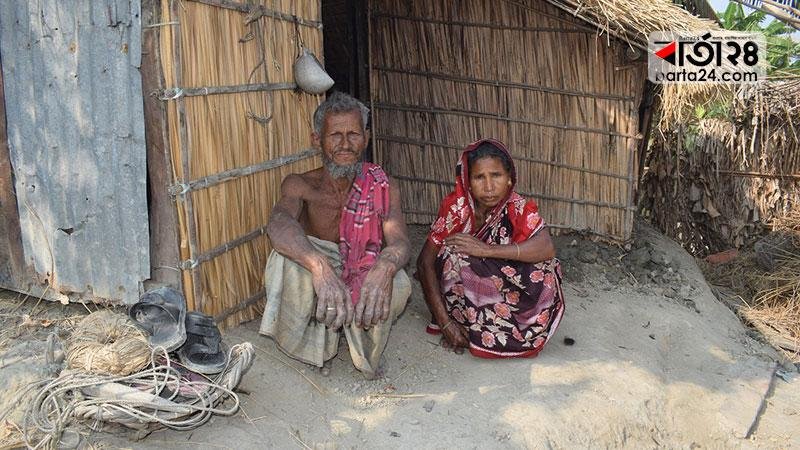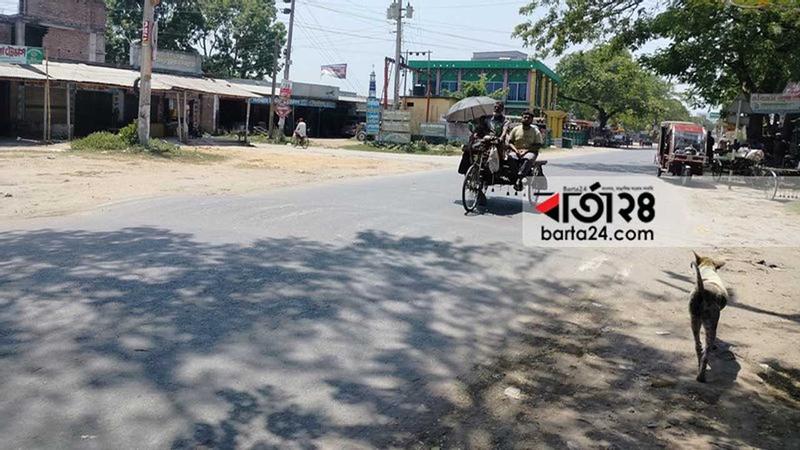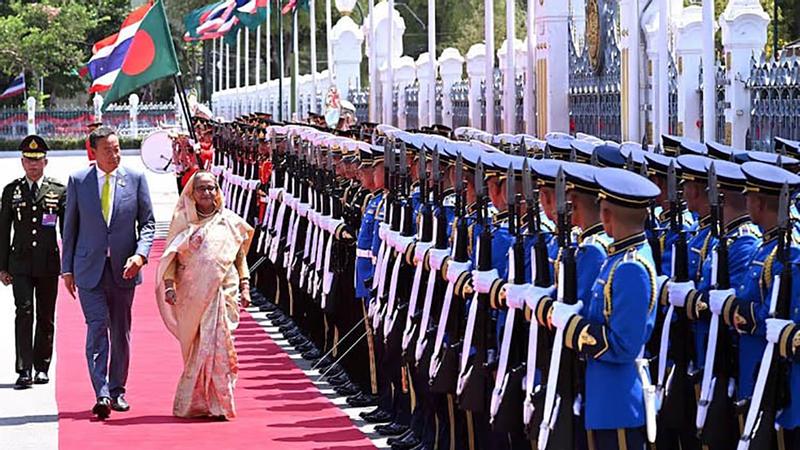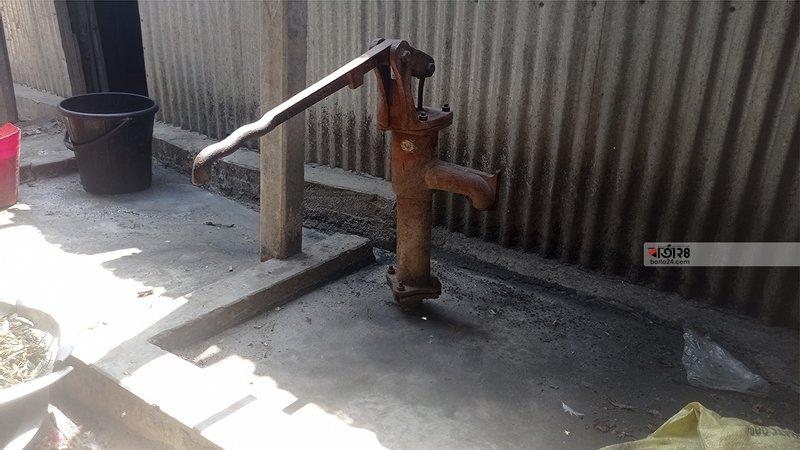How the coastal people are adjusting with the disaster?

Photo: Rafiqul Islam Montu
All quiet around at noon. Roads were looking desolate. A few fishing boats were floating on the nearby river. The chirping of birds on the branches of trees by the forest was heard.
Ilias Hossain and his wife Morzina Begum have not stopped working since that morning. There is no way to stay indoors at night if you can't attach four bamboo poles. Many days have passed on the shaky poles. There is a fancy story of adapting to disaster with bamboo poles.
This picture came up in my notebook from Kalabagi village in Dakop upazila of Khulna district on the west coast. Hundreds of houses in this village hang like this with these bamboo poles. The wooden deck has been leveled with poles. On top of this the settlement year after year. No, no one has taught this technique to the people of this area. They have learned from the disaster that if you want to live here, you have to build a house like this. All the houses of this village were at one time in the land on the ground. There was no need to build a loft. There was a yard in front of the house. Children used to play in that yard. There was a vegetable garden around the house. But the catastrophic cyclone Aila of 2009 took them away. That is what Ilias Hossain, a resident of Jhulanta village, was saying.
Have you seen the wave of river? There was my house. The days were going well by working. There was little land. I used to cultivate. But Aila came and finished us all. We lost our home. Now the way to earn income is also stopped. There is no house. In the end I am building a house like this. Where to go? There is no alternative but to stay here. The tide rises, so I raised the deck. Now this is our home. '
The residents of Kalabagi village have come up with their own strategy to survive the disaster. With the passage of time when there was no other way to put head then the house was built in the water in a special way. There are many stories of surviving disasters across the coast. Where people do not have the opportunity to make hanging houses, the house is built on a high floor. Someone pulls a rope around the house to avoid disaster. To get out of the house easily in times of disaster, they also have such a strategy. Large wooden boxes are kept in each house to store the essentials of the house.
I asked Ruhul Amin Mridha (60) of Char Abdullah Teli Char in Ramgati Upazila of Laxmipur, why did he raise the floor of the house so high? He replied, this is as much land as you see in Char, water rose everywhere. The floor of the house is about seven feet high. Even then the water touches the house. What do we do, we have no way. We have learned from the danger of tidal waters, we have to live like this. We have no other choice. How many times that my house has gone to the river, no account. I have come here in the forest and built a house. '
Just like Amin Mridha's house, the roof of the island houses is high but the shed is very low. What is the reason for this- Amin said, the roof should not be blown away by the storm, that is why this strategy.
Coastal dwellers use the technique of tightening the rope around the house to avoid disaster. So that the house is not tilted in the rain can't collapse or the shed of the house cannot be blown away, that is why this system. There are some such houses in different areas of the coast.
Numerous such houses have been found in the Tablar Char area south of Kutubdia in Cox's Bazar on the east coast. It is difficult to keep the houses safe as it is very close to the sea and the embankment is very low. The shed around the house is almost paved with soil, so as not to damage the storm. This is not the end. The roofs of the houses are covered with black polythene and bricks. There are ropes in the four corners of the house. Not only in Kutubdia, but when the disaster season comes, people from different parts of the coast start preparing to tidy their houses in this way.
To escape the disaster, the people of the coast leave the scaffolding of the house a little empty. Why this strategy? Answering the question Bashir Uddin (55) of Teli Char said, ‘even if the water level of the tide rises abnormally, the people of the house should be protected, that is why this arrangement. I keep the sheds loose during disasters. So that you can climb up through the gap of the deck and climb up effortlessly. The shed will float in the water since people can survive even if they are sitting on the roof. Such a strategy is based on this thought. '
In this way, Ainar Hossain of Char Patila was telling the story of surviving a catastrophe. He said, ‘All the houses in Char were submerged during Sidr. A Char people named Sirajuddin grew up in a house with his family. Floating on the roof of the house, Siraj was saying, we are going floating, pray for us. It was later found out that the whole family survived because of being swept away. '
Kanchan Ali, a resident of Dwip Union Madanpur in Daulatkhan, Bhola district, left several large water drums around the roof of the house. As soon as you enter the house, you can see them. The question arises, why so many drums? I wanted to know from Kanchan Ali. From what he understood, this drum is a fancy strategy to survive the disaster. "We live by relying on destiny," he said. There is no one to protect us here. Yet I make some arrangements myself. These drums can be used during tidal surges. If everyone in the family can stay afloat with one or two drums, they will survive.
After seeing these drums in Kanchan Ali's house, there are rows and rows of drums in many places along the coast which saves the people of the coast from danger.
Large wooden boxes can be seen in most of the houses when you visit the coastal areas. I have heard some people call it, Meatcase or Meatsafe. This wooden box serves as a shelf to protect goods from disasters. But how? Minara Begum, a resident of Char Patila in Char Fashion Upazila of Bhola was talking about the function of the box during the disaster, she said, ‘All the handy goods in the house are kept here. She said, ‘We keep all the handy items in this box. Anything that is valuable, it stays inside. If there is ever a danger, a storm, the goods in this box will be fine. Such a heavy box may not fly easily. I will find it at least after the storm. '
From his words, it is understood that this big box is quite helpful in storing household goods in times of disaster.
The people of the coast keep some extra ropes somewhere in the house to be used in case of emergency. One said, ‘This rope may be needed to tie something in a strong wind. That is why extra rope is kept in the house. They also take special initiative to protect cattle. In times of calamity, cattle are kept on the high ground next to the house. Many cut the ropes, so that they can run away in danger. Many stockpiled dried food in case of disaster, so that we do not have to suffer from hunger during disasters.
Millions of people on the coast have survived various natural disasters, including cyclones and tidal surges. Climate change has increased the level of disaster on the coast. People get various experiences after falling into these disasters. Despite being in danger again and again, they have to stay on the coastal islands in search of livelihood. On their own piece of land, little wealth seems to be their only means of survival. So to survive with nature they learn the techniques. At one time people adapted themselves to these disasters. Survive with disaster. One by one they learn from a natural disaster with a new strategy of survival. Cyclone Amphan may also teach the struggling people of the coast something new.















